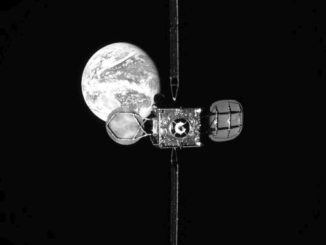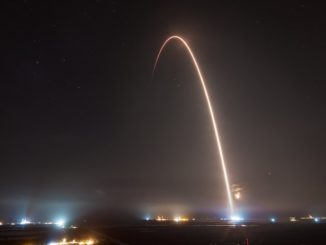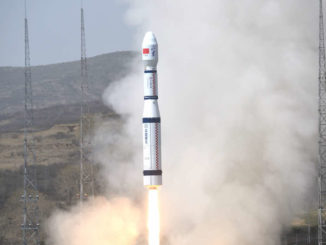
A refrigerator-sized satellite soared into orbit aboard an air-launched Northrop Grumman Pegasus XL rocket Thursday night over the Atlantic Ocean, finally setting off on a $252 million mission to probe the dynamic boundary region where space and Earth’s atmosphere meet.
NASA’s Ionospheric Connection Explorer, or ICON, satellite rode to space at the tip of the winged Pegasus XL launcher on a mission delayed more than two years by problems with the rocket.
The 634-pound (288-kilogram) ICON satellite carries instruments to track variability in the ionosphere, a layer in the upper atmosphere where the auroras are generated. Conditions there can impact satellite communications, GPS navigation and electrical grids.
A modified L-1011 jetliner took off around 8:31 p.m. EDT Thursday (0031 GMT Friday) from the Skid Strip airfield at Cape Canaveral Air Force Station. After heading east over the Atlantic Ocean, the L-1011 flight crew guided the airplane on a race track pattern to line up for a pass through the Pegasus drop box around 100 miles (160 kilometers) east-northeast of Cape Canaveral.
Officials originally planned to release the 57-foot-long (17-meter) rocket at 9:30 p.m. EDT (0130 GMT), but a communications issue forced the team to abort the drop. The L-1011 carrier jet, named “Stargazer,” circled around and line up for another launch run at an altitude of 39,000 feet (11,900 meters) on an east-southeast heading.
The launch panel operator inside the L-1011 activated the rocket’s fin batteries in the final minute of the countdown. The Pegasus first stage’s rudder and twin elevons completed a sweep test before L-1011 co-pilot Steve Gunn pushed a button in the cockpit to release the nearly 53,000-pound (24 metric-ton) rocket.
After dropping for five seconds, the Pegasus XL’s winged first stage ignited and powered up to produce 163,000 pounds of thrust. The rocket pitched up to fly at an angle of 35 degrees as the first stage propelled the Pegasus to an altitude of 177,000 feet (54 kilometers) in less than a minute-and-a-half.
The first stage burned out and jettisoned, followed seconds later by ignition of the Pegasus second stage. The rocket’s nose cone separated at around T+plus 2 minutes, 10 seconds, once the Pegasus climbed above the dense lower layers of the atmosphere.
The second stage burned out just shy of the three-minute mark of the flight, and the Pegasus coasted for several minutes before the third stage motor fired to finish the job of placing NASA’s ICON satellite into orbit.
The Pegasus rocket placed the ICON spacecraft into an orbit ranging between 356 and 382 miles (574-by-616 kilometers) above Earth, with an inclination angle of around 27 degrees to the equator.
“All of those values are on target,” reported launch conductor Adam Lewis.
A refrigerator-sized satellite soared into orbit on an air-launched Northrop Grumman Pegasus XL rocket Thursday night over the Atlantic Ocean, setting off on a $252 million mission to probe the dynamic boundary region where space & Earth’s atmosphere meet. https://t.co/s4b97nLOkZ pic.twitter.com/9e8Qwxj8C2
— Spaceflight Now (@SpaceflightNow) October 11, 2019
As expected, ground tracking stations lost contact with the Pegasus rocket before deployment of the ICON satellite. Ground controllers waited a few minutes for NASA’s network of tracking and data relay satellites to receive the first signals from ICON after separation from the Pegasus third stage.
The telemetry data confirmed a good deployment from the Pegasus third stage, and NASA said the spacecraft was “power positive” after arriving in space, indicating it was generating electricity from its solar panels.
ICON was supposed to launch in 2017, but the mission’s start has been delayed more than two years, first when technicians dropped one of the Pegasus rocket’s solid rocket motors during ground processing, then to examine a concern with a mechanism required to separate the rocket’s fairing and release the ICON satellite in orbit.
NASA and Northrop Grumman stood down from two launch campaigns last year to analyze recurring erroneous data signatures from the Pegasus rocket’s rudder.
“This one has been a long time in coming,” said Omar Baez, NASA’s launch director for the ICON mission. “We had some setbacks early on, in the middle of last year, and I’m glad that we were able to get this payload up in orbit and in a safe condition.”
“The orbit looks fantastic, and currently they’re power positive (on the ICON satellite), so everything looks fantastic for us,” Baez said. “A wonderful Pegasus launch, and like always when you’re launch pad is moving at 500 or 600 mph, things happen. And this time, the first attempt got us because we lost positive communication between the aircraft and the ground, and our rule is to abort the flight, go back around and try it again.”
ICON will begin regular scientific observations in late November with a suite of four instruments.
“ICON has an important job to do – to help us understand the dynamic space environment near our home,” said Nicky Fox, director for heliophysics at NASA Headquarters in Washington. “ICON will be the first mission to simultaneously track what’s happening in Earth’s upper atmosphere and in space to see how the two interact, causing the kind of changes that can disrupt our communications systems.”
The launch of NASA’s ICON satellite was the 44th satellite delivery mission for the Pegasus rocket since its debut in 1990. Originally developed by Orbital Sciences Corp., now part of Northrop Grumman, the Pegasus rocket has accomplished 30 consecutive successful satellite launches with Thursday night’s mission.
But the future of the Pegasus rocket, once a workhorse for NASA’s small satellite programs, is unclear after the long-delayed ICON launch.
There are no more missions on the Pegasus rocket’s manifest, and a recent NASA launch contract that was expected to likely be awarded to Northrop Grumman for a Pegasus flight went to SpaceX instead.
The Pegasus is not competitive in the commercial launch market because of its high price, but Northrop Grumman, and its predecessor Orbital Sciences, found a niche market for the Pegasus in recent years to loft NASA satellites that needed dedicated launches into unique, mission-specific orbits.
Northrop Grumman has hardware in inventory for two more Pegasus XL rockets. Those vehicles were purchased by Stratolaunch, a company founded by the late Microsoft co-founder Paul Allen, to launch of its own giant rocket carrier aircraft.
Stratolaunch’s rocket mothership — the largest airplane in the world — completed its first test flight April, but has not since flown again. Early this year, months after Allen’s death, Stratolaunch shelved plans to develop its own rocket to focus on readying for a demonstration launch of the Pegasus XL rocket.
Northrop Grumman recently bought rights to the Pegasus XL rockets back from Stratolaunch, and the company is seeking to sell the rockets to NASA or the U.S. military, according to Phil Joyce, Northrop Grumman’s vice president of space launch programs.
The aerospace and defense contractor has also purchased a second L-1011 aircraft to salvage spare parts for the Pegasus carrier jet. Joyce said.
“We’re looking out five or 10 years with the L-1011, and what parts do we need, being the only flying L-1011 on the planet,” he said. “We have the only trained pilots, we have the only trained mechanics for that aircraft, and we needed the parts.”
Like the Pegasus XL launcher, the ICON satellite was built by Northrop Grumman. It’s based on the company’s LEOStar 2 satellite bus.
The ICON mission will investigate the link between conditions in the ionosphere, which scientists long thought was primarily driven by solar activity, and weather deeper in Earth’s atmosphere.
“The ionosphere is the densest plasma in space between us and the sun, and that plasma has a number of effects on systems that we use every day,” said Thomas Immel, ICON’s principal investigator from the University of California, Berkeley.
Immel proposed the ICON mission to NASA, and the agency selected the ICON proposal for development in 2013.
The ICON mission will study “how weather in our lower atmosphere, the weather we experience from day to day, influences conditions in space,” Immel said. “This coupling of the lower atmosphere to the upper atmosphere is a new science topic for NASA.”

Credits: NASA’s Goddard Space Flight Center/ICON
Previous satellite missions detected the unexpected coupling between plasma waves and winds in the ionosphere and terrestrial weather systems.
“What we discovered, using data from a NASA mission called IMAGE, was that this region of the upper atmosphere and ionosphere was actually responding to effects related to weather systems near Earth’s surface,” said Scott England, ICON project scientist based at Virginia Tech. “This was really unexpected at the time, to see a connection. Where the charged particles were, how many there were, how dense the gas was — they were responding to weather patterns near the surface of the Earth.”
“We saw with those missions that the density in the ionosphere varied in response to changes in the rainy seasons in the tropics,” Immel said. “The new mission of ICON is to focus on that topic, and we’re carrying the instruments to invesitgate that region.
“We think focusing on that will give us a real key to understanding and making better predictions for space weather,” he said.
ICON carries four types of instruments developed at the University of California, Berkeley, the Naval Research Laboratory, and the University of Texas at Dallas.
Another NASA mission named GOLD — short for Global-scale Observations of the Limb and Disk — has objectives that intersect with ICON’s planned observations.
GOLD is mounted on a geostationary satellite more than 22,000 miles (nearly 36,000 kilometers) over the equator, providing wide-area views of the airglow in the ionosphere.
“ICON is going to come along and provide those in situ measurements, flying right through some of those plasma bubbles that we’ve been imaging with GOLD for a year now,” Fox said.
If ICON had launched on its original schedule, it would have been in space before GOLD.
“There has been a two-year delay,” Fox said. “We have learned a little bit more science. We now have a year’s worth of GOLD images, so I think, if anything, we’re even more excited about what ICON is going to bring to us.”
Email the author.
Follow Stephen Clark on Twitter: @StephenClark1.



